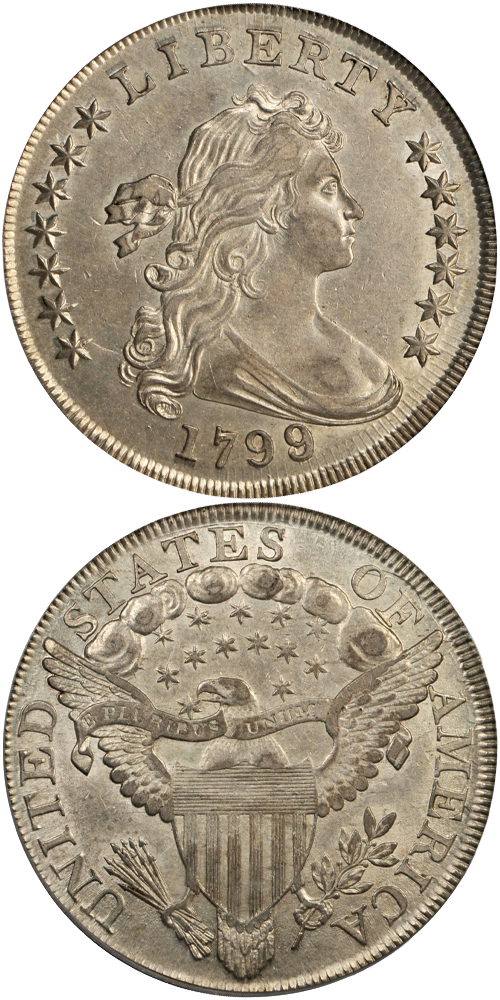1799/8 Draped Bust Dollar
15 Stars
This fascinating variety is struck from the only reverse to depict 15 stars in the reverse cluster, two of which are nearly totally obscured by clouds at either side of the topmost arc. These clouds are considerably larger than the others, suggesting the engraver used them to cover his errant cosmology. This reverse was first married to a non-overdated 1799 obverse to create BB-153, and then married to this overdate obverse to create the present marriage. In this state, the reverse shows significant clashing at OF AM, along with a peripheral arc crack above TES of STATES. The left top of I is connected to the denticles above with a thin vertical crack. Spalling is noted after D of UNITED, inside the right side of the shield, and right of the eagle's torso. The obverse shows a stream of spalling breaks between star 7 and L of LIBERTY, downward to the crown of Liberty's head. Other die flaws are noted above the right top of R of LIBERTY and below RT. Both 9s of the date are recut atop the previously placed 98.
This variety has been popular and notable for as long as early dollars have been collected by variety. J. Colvin Randall was a pioneer in the identification of die varieties of early silver and gold coins. He was an early analogue of what would today be termed a "vest pocket" dealer, buying and selling individual coins and whole collections, both privately and at auction. His mainline collection was sold in 1885, while his retirement collection was acquired by J.P. Morgan after Randall's death in 1901. Randall's primary published contribution to numismatics was misappropriated by his sometimes partner John Haseltine, who printed Randall's die variety project as the Haseltine Type-Table, a name that has endured since 1881. The Type-Table appears to be the first place this variety was identified in print, described as "obv. same as No. 1; rev. 15 stars, 2 of them entirely concealed by the clouds on extreme right and left, the points just barely emerging." Bolender's numbering system largely followed the Randall/Haseltine work, rendering Haseltine-3 as Bolender-3 for most collectors after 1950.
It is clear that Mint engravers attempted to place a star for each state of the Union on coinage dies up to 1797, an effort that gave us 16-star half eagles, dollars, half dollars, dimes, and half dimes that year. One 1798 obverse was made with 15 stars, an odd retreat, theorized to have been made (except for its date) at a time in 1795 or 1796 when there were 15 states. As dollars did not feature the Heraldic Eagle reverse type until 1798, that explanation seems unlikely in this case; simple human error seems more likely.
The example to the left was sold by Stack's Bowers Galleries in the March 2013 Baltimore Auction, where it realized $10,575.






